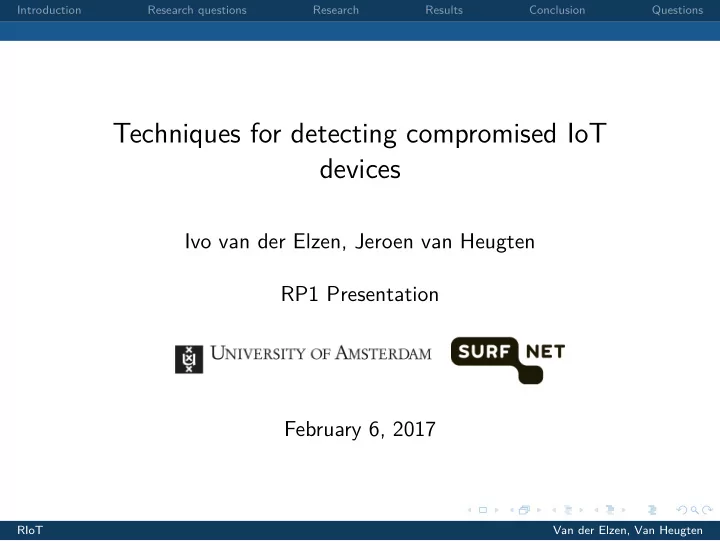

Introduction Research questions Research Results Conclusion Questions Techniques for detecting compromised IoT devices Ivo van der Elzen, Jeroen van Heugten RP1 Presentation February 6, 2017 RIoT Van der Elzen, Van Heugten
Introduction Research questions Research Results Conclusion Questions Introduction RIoT Van der Elzen, Van Heugten
Introduction Research questions Research Results Conclusion Questions Research questions • Which techniques are feasible in order to gather insight into infected IoT devices? • What are the generic properties of existing IoT malware? • What techniques are available to detect IoT malware activity based on these properties? • Which technique or combination of techniques is/are most appropriate for a given set of resources or network location? RIoT Van der Elzen, Van Heugten
Introduction Research questions Research Results Conclusion Questions Malware analysis: Mirai Mirai overview Credit: Level 3 Threat Research Labs RIoT Van der Elzen, Van Heugten
Introduction Research questions Research Results Conclusion Questions Malware analysis: Mirai (cont.) • Scanning • Random IP (/32), with exclusions • Ports targeted • Peculiar window size • Attacking • List of 60 username/password combinations • Check string busybox MIRAI & ECCHI • Results sent to loader • Infection • Loader delivers malware • Removes competing bots • Many processor architectures supported RIoT Van der Elzen, Van Heugten
Introduction Research questions Research Results Conclusion Questions Malware analysis: BASHLITE AKA: Torlus, gafgyt, Lizkebab • Very simple client/server setup • scanner ”Lel” • DDoS attacks • C&C IRC-derived RIoT Van der Elzen, Van Heugten
Introduction Research questions Research Results Conclusion Questions Malware analysis: BASHLITE (cont.) • Scanning • Random IP subnet (/24), with exclusions • Targets port 23 only • Window size unset (system default) • Attacking • Uses random combination of 6 usernames and 14 passwords • Bot downloads shell script that downloads the malware • Infection • Script downloads binary for each arch • Many processor architectures supported RIoT Van der Elzen, Van Heugten
Introduction Research questions Research Results Conclusion Questions Other malware targetting IoT devices Some more • Zollard • Hajime • Anime/Kami • and many more... RIoT Van der Elzen, Van Heugten
Introduction Research questions Research Results Conclusion Questions Generic properties of IoT malware Difficult to be comprehensive... but: • Lifecycle • Scan for devices with open ports • Attack devices • Infect compromised devices • Perform intended actions (DDoS) • GOTO 10 RIoT Van der Elzen, Van Heugten
Introduction Research questions Research Results Conclusion Questions Generic properties of IoT malware (cont.) • Scanning behavior • Random scan of IPv4 address space, with exclusions • Ports targeted • Much code shared, but some peculiarities • Attacking • Main attack method: weak/default username/password • Sometimes exploits are used • Infection method varies • BASHLITE: Bots scan & attack, drop/fetch binary • Mirai: Bots report results to loader, loader drops binary • Hajime: Drops small binary that fetches malware over DHT and uTP RIoT Van der Elzen, Van Heugten
Introduction Research questions Research Results Conclusion Questions So wat defines IoT malware? IoT malware is mostly defined by which types of devices it targets: • IP camera’s, DVR’s, home routers and other ”embedded” devices • Effective due to support for many architectures, not just x86 • Almost any Linux device with an open telnet and weak password susceptible! Credit: Hangzhou Xiongmai Technologies RIoT Van der Elzen, Van Heugten
Introduction Research questions Research Results Conclusion Questions Detection techniques • NetFlow • Packet capture • Honeypots • Other RIoT Van der Elzen, Van Heugten
Introduction Research questions Research Results Conclusion Questions Detection techniques: NetFlow • Lower OSI layers • Packet headers • Network monitoring • Accuracy Credit: Cisco Systems RIoT Van der Elzen, Van Heugten
Introduction Research questions Research Results Conclusion Questions Detection techniques: Packet capture • All OSI layers • Packet headers & payload • Troubleshooting • Performance RIoT Van der Elzen, Van Heugten
Introduction Research questions Research Results Conclusion Questions Detection techniques: Honeypot • Cowrie (medium-interaction) • Tracking malware variants • Gathering infected IP addresses • Full-interaction honeypots • DDoS attack targets • C&C IP addresses Credit: The Honeynet Project RIoT Van der Elzen, Van Heugten
Introduction Research questions Research Results Conclusion Questions Detection techniques: Other • DNS analysis • DGA • Open/closed port monitoring • Shodan • CAMELIA RIoT Van der Elzen, Van Heugten
Introduction Research questions Research Results Conclusion Questions Experiments • Mirai PRNG window size v.s. darknet scans • Mirai scanning behavior compared to NetFlow • Telnet honeypots RIoT Van der Elzen, Van Heugten
Introduction Research questions Research Results Conclusion Questions Results Window sizes of TCP SYN packets captured by darknet monitor RIoT Van der Elzen, Van Heugten
Introduction Research questions Research Results Conclusion Questions Results (cont.) Compared to Mirai’s window size algorithm (note change of scale!) Conclusion: Window sizes used by Mirai very uniformly distributed, this is unusual. RIoT Van der Elzen, Van Heugten
Introduction Research questions Research Results Conclusion Questions Results (cont.) Simulated Mirai v.s. suspected Mirai bot Mirai/Hajime variants seen by honeypots MIRAI 3147 MASUTA 1835 MM 309 OBJPRN 215 MEMES 29 THTC 18 ECCHI 18 TERROR 5 LLDAN 2 TASKF 2 FBI 2 Subtotal 5582 5 random characters 7624 Total 13224 Unique source IP / string combinations seen RIoT Van der Elzen, Van Heugten
Introduction Research questions Research Results Conclusion Questions Conclusion • Determine generic properties of IoT malware? • Yes, but needs to be updated periodically • Feasible techniques • NetFlow analysis • Packet capture (Darknet) • Honeypot logging • Other Conclusion: Detection techniques can only be effective when applied with knowledge of malware gained from sources such as honeypots and malware analysis. RIoT Van der Elzen, Van Heugten
Introduction Research questions Research Results Conclusion Questions Questions Thank you! Any questions? Special thanks to SURFnet for hosting us and the use of their data and expertise. RIoT Van der Elzen, Van Heugten
Recommend
More recommend